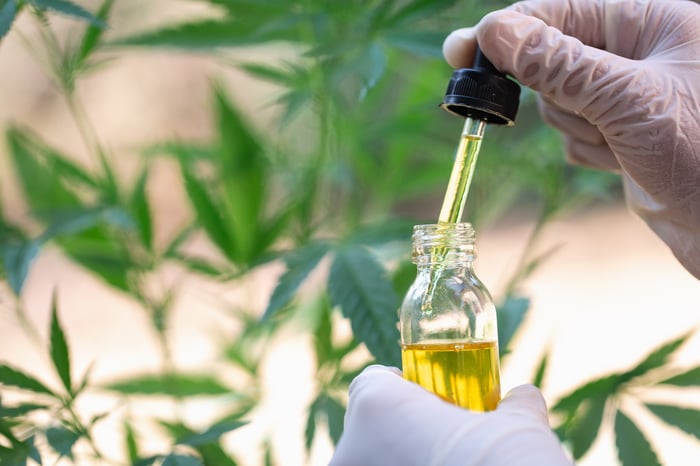The marijuana industry has been kicking "bud" and taking names since the year began. Through April 23, the broad-based S&P 500 was up 17% year to date, representing one of its strongest starts to a year in decades. Comparatively, though, the Horizons Marijuana Life Sciences ETF, the first cannabis exchange-traded fund, had gained 45%, leaving the broader market to breathe in its secondhand smoke.
Investors are clearly enamored with the prospects of recreational legalization throughout North America. Canada became the first industrialized country in the world to green-light adult-use cannabis in October 2018, and momentum appears to be building in the United States to reform existing federal weed laws, which still hold cannabis to be a wholly illicit drug that's prone to abuse and has no recognized medical benefits. This call for reform is made even stronger with two-thirds of all states having legalized medical pot in some capacity, and two-thirds of all Americans in favor of broad-based legalization, per Gallup.
But make no mistake about it -- growing momentum does not make every marijuana stock a buy. In fact, it makes unproven penny stocks potentially all the more dangerous.

Image source: Getty Images.
Certain marijuana penny stocks may look promising...
One such marijuana penny stock that looks to have its act together on the surface, but is actually bad news once you do some digging, is Medical Marijuana (MJNA -20.00%), the first-ever cannabis stock to list its common stock for trade in the United States -- albeit on the over-the-counter exchange. Although trading at only $0.06 per share, it's more than 3.5 billion outstanding shares yields a somewhat respectable $219 million market cap.
Nearly two weeks ago, Medical Marijuana released its fourth-quarter and full-year results, painting a picture of solid progress as a producer and distributor of cannabidiol (CBD) and hemp-based oil products. CBD is the nonpsychoactive cannabinoid best known for its perceived medical benefits. Contained within its report were numerous surface-scratching achievements.
For instance, the company recognized sequential quarterly sales growth throughout the year, and ultimately came within a stone's throw of registering $60 million in annual revenue. Removing cost of goods sold, Medical Marijuana recorded a gross profit of $40.34 million.
Aside from organic growth opportunities, Medical Marijuana also stands to benefit from the December passage of the Farm Bill. Signed into law by President Trump, the Farm Bill legalizes the commercial production of hemp and hemp-based derivatives. Since hemp is a relatively cheap and abundant source of CBD, this law plays right into Medical Marijuana's long-term goal of growing its Kannaway and HempMeds distribution businesses.
Among CBD manufacturers, it's also done a pretty impressive job of pushing into foreign markets. HempMeds, which supplies hemp oil products, has a presence in Mexico and Brazil, while Kannaway is currently focused on the U.S. and European Union, with eyes on Canada and Mexico in the near term.

Image source: Getty Images.
... but they're almost always trouble
Yet, for every achievement listed, there's a valid reason Medical Marijuana's stock has tumbled 19% since the year began, while practically every other pot stock has risen.
To begin with, the company isn't making money an operating basis, despite rapid sales growth. Even with a 67.4% gross margin, total expenses soared to $48.36 million, leading to an operating loss of just over $8 million. For what it's worth, HempMeds came very close to being profitable on an operating basis, but it only represents a little more than 10% of total sales. Costs rising at the same pace as sales, or even faster, has been a constant theme for Medical Marijuana since its founding.
Secondly, after briefly panning out, the company's investments have proven to be a major drag on its bottom line over the past two years. At the end of 2018, Medical Marijuana held an approximate 38% equity stake in microcap Axim Biotechnologies, a cannabinoid-based drug and drug-products developer. Shortly after Medical Marijuana's initial investment, Axim's stock soared from around $0.25 to north of $20 per share, substantially inflating Medical Marijuana's total assets. But Axim has given back almost all of its gains since peaking in early 2017, with its shares closing at $1.62 last Tuesday. This resulted in Medical Marijuana taking a nearly $190 million adjustment on its investments in 2018, pushing its annual loss to $202.6 million. Yuck!
Third, the company's balance sheet is hiding a pretty ugly secret. And I say "secret," because most investors don't really give balance sheets the once over they really deserve. Of the $92.96 million in total assets Medical Marijuana ended 2018 with, $45.37 million of it was goodwill, with another $25 million being investments (i.e., mostly Axim). Put in another context, 76% of Medical Marijuana's equity is built on hope. The hope that it'll recoup the premium it paid for acquisitions, and the hope that Axim's stock doesn't implode any further. Last I checked, "hope" isn't a valid investment thesis.

Image source: Getty Images.
Last, but not last, this is a company that has a long history of financing its business by selling common stock and convertible debentures (which can be eventually turned into common stock), thereby diluting the value of the existing shares. Having ended the year with only $4.29 million in cash, but losing $8 million on an operating basis, additional common stock sales are to be expected.
Penny stocks in a fast-growing industry might be alluring, but trust me, you don't want to take the bait.





